Theory and Analysis:Final Scene in End of Evangelion
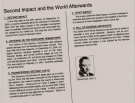
|
"The story presented to the public was just a cover-up." |
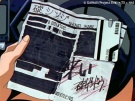
|
"You mean you couldn't read the questions in Japanese?" "Right, I haven't learned all the Chinese characters yet. We didn't study it in college over there." |
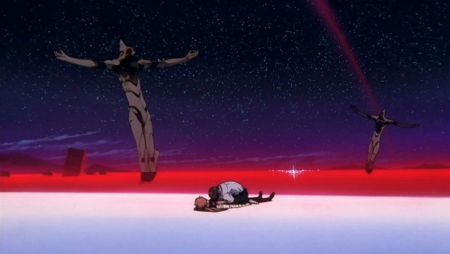
The final scene of End of Evangelion is source of some of the most fruitful discussions among fans over the years, based on in-depth analysis, interviews with the Seiyū, theories based on philosophy and much more. This article aims to assess some of the main points of view that have emerged over the years, building a solid narrative about what we can extract from the scene and its meanings within the show.
It is important to keep in mind that the information described here is sourced from information of different canonical validity and partial translations. Thus, there may be conflicting analysis and points of view, however, this does not invalidate these sources as a whole, as they have the purpose of helping to elucidate plot points. It is up to the reader, however, to keep in mind that this type of information is susceptible to falsifiability and may be modified later.
ONE MORE FINAL: I need you.
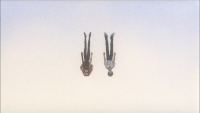
After the eyecatch, we're introduced to the dead figure of Lilith, with half of her face gone and in a enigmatic, stoic expression. Ahead of her, we can see stakes raised in the ground, with one of them broken. The scene focuses on another one, showing the cross that Misato gave to Shinji, in a rusted state.
The scene of a petrified Eva in a deteriorated state is shown, and then a beach scenario is presented, with a red sea, result of the LCL that was diluted during Third Impact. The Moon is shown with a bloodstain as result of Lilith's death. This scene will still be emphasized a few times during the sequence.
We are then shown to the two surviving protagonists: Shinji and Asuka. They are lying side by side with their eyes open. Their hands are shown next to each other. Asuka has her arm bandaged, it's the same arm that was severely injured during the battle with the Mass Production EVAs.[1]
Shinji then looks to his left with an expression of confusion. From his point of view we are shown Quantum Rei, apparently floating amidst the sea of LCL, which we can now see clearly that it’s above the city's buildings. Shinji's gaze changes from confusion to a stoic tone as Rei's mysterious figure disappears. Shinji stands up in the same way and then heads to Asuka. We are presented with more exterior scenes: the destroyed and submerged city, the enigmatic vision of the Moon, and the bloodstain in the sky, which basically forms a red rainbow.
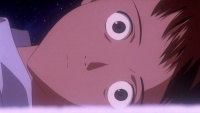 |
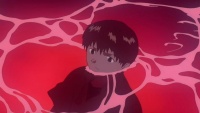 |
The next scene starts one of the most discussed sequences in the franchise: Shinji climbs on Asuka and starts strangling her, increasing the pressure of his fingers on her neck. Asuka visibly suffers, but her reaction is to caress his face, slowly and calmly. Immediately, Shinji releases her and his tears fall onto Asuka's face. He is sobbing, finally sketching a stronger reaction in this sequence, as she is shown with an, once again, enigmatic and stoic face. With the scene returning to show the two of them apart, Asuka utters the last sentence of the film: kimochi warui, which can be translated as “I feel sick” or “How disgusting”.[2] The film ends.
Passage of Time
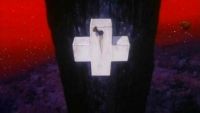
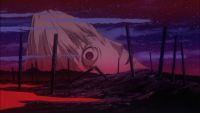

It appears likely that Shinji might have spent some time alone in the beach before Asuka showed up, as some elements in the scene indicate:
- There are several standing pieces of wood that, according to the script[3], are meant to resemble grave markers, one of which has been broken in half. This could be interpreted as Shinji setting up grave markers for all those whom he knew. The one with Misato's cross would, therefore, represent her grave. It is also possible to see a Yebisu can near of her “grave”, in a certain state of deterioration.
- Misato's cross is rusted, or more specifically, the nail that is holding it. It has been suggested that this could merely be blood washed over on the cross, as LCL is said to resemble blood multiple times. However, the fact that rust is specifically falling from the nail is telling, because it means that either there has been enough time for a nail to rust, or, alternatively, if Shinji found the nail already rusted, the water or humidity could have made the rust spill on the cross. Regardless, there needs to at least have been enough time for the rust to drip down in the first place.
- The moon cycles change between the first post-Impact scene when Lilith is dying to the ending scene. Assuming that the moon hasn't been affected by the events of Third Impact, they seem to indicate at least two weeks have passed between those scenes.[4]
A much longer time than that would become increasingly difficult to sustain, as Shinji physically doesn't look so different from his natural state, with his clothes in a decent state, except for his dirty shoes. He doesn't seem to have aged significantly either.
What we can speculate is that this is the first time Shinji has met another person after the end of the Third Impact, regardless of how long it has been. Why he was lying on Asuka’s side can be discussed later with other evidence. As such, this scene probably takes place shortly after Asuka returns to her physical state, with her body healed but wrapped in bandages. Whether she moved to Shinji by her own decision or whether he found her is unknown.
The passage of time linked to Shinji Ikari's mental state is also the result of a lot of debate, considering that he leaves the instrumentality in a relatively positive state of mind, willing to live in the real world, but has eradic and bizarre actions when encountering another human being, indicating a supposed state of mental suffering. His ability to discern between the real world and instrumentality could be severely affected, leading Shinji to a state of disbelief. The short appearance of Quantum Rei enhaces his doubt, given the unreality of the scene. The aggression, in that case, would be a way to confirm that it was the real world, since the real Asuka would fight for her life or react in order to avoid his approach.
Factors such as survival, nutrition and the general state of the world are left to the public's interpretation. In fact, it's not even possible to imply that Shinji and Asuka are the only humans to have come back to life at that point[5], but rather that it's the first time they've met each other. These points also help to elucidate the symbolic and metalinguistic aspect of this sequence, expressing the reestablishment of humanity's contact the other, on an individual level.
Stranging and Hands Symbolism
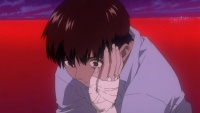
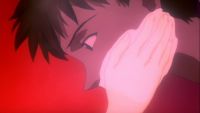 |
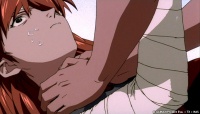 |
Throughout the anime, scenes involving hands, and more specifically, strangulations, can be described as prominent. Metaphorically speaking, hands are a form of connection between one person and another, through contact, and also an indicator of self-reflection, especially in the case of Shinji. End of Evangelion is very consistent in establishing this pattern, since hands are the result of different types of contact with other people: both for violence and for a peaceful contact. Shinji makes this kind of contact with Asuka and Rei in different parts of the film, and other characters do the same throughout the show, such as Gendo (in the case of Rei 3) and Naoko Akagi (in the case of Rei 1).
In an intrapersonal way, Shinji is often seen looking down at his hands during the show. Whether to make decisions (episode 1), reflect on your abilities as Eva pilot (episode 16), or condemn himself act after masturbating to Asuka (EoE/25'). This act in itself denotes how the character has disbelief in his own attitudes and doesn't know very well how to approach others. In all these scenes, Shinji mostly demonstrates insecurity, an important marker of his personality. A more emphatic attitude with the hands needs greater mental strength for Shinji to be able to perform. Interestingly, it is also through his hands that he controls his Eva, reflecting the weight that is in them, even though he is not sure about his attitudes and their meaning. With that said, when Shinji freely uses his hands to hurt, perhaps the weight he feels is lesser, because he is abdicating his relationship with the other, rejecting them.
Speaking specifically about the choking scenes, which also set a pattern in the show, and using the metaphor of connecting with others, this kind of aggression can be described as a denial of the other. This denial can mean rejection, distancing, or, more directly, death. In the same way that Naoko strangles Rei 1 by denying her as a human being, and rejecting her as a image of Yui Ikari, Shinji strangles Asuka by denying her as another one (just as he did with her earlier, in the kitchen scene). However, Asuka uses her hand in an opposite way: that of acceptance, willing to accept Shinji's condition as another, and this act itself shocks Shinji deeply. In this way, he manages to accept the reality he witnesses and stops denying it to the other. The expression of affection is a symbol of the new possibilities of humanity, free from Instrumentality.
Script Evidence & Interviews
These script details are lower-level Tier 1 canon material since they come from the show's production, and can be considered highly reliable supplements to the material already seen in End of Evangelion itself as long as they do not explicitly contradict anything that is seen onscreen. They also provide general hints of the ideas surrounding the scene conception.
See also: Resources:End of Evangelion Screenplays
The End of Evangelion script presents some details that help to assemble the existing puzzle in the scene. The following material has been disputed by more fanbase discussions over the years, but has been consistent with evidence that has emerged later, such as releases of extra material on blu-ray. As such, this section is dedicated to exploring the story behind the creation of the final sequence, using these resources to understand the ideas that permeated its creation, the opinions of the authors and Voice Actors, and their general impact for the final result.
To start with, we can talk about the differences between the script provided and the movie itself. Some details are modified, indicating simplifications and changes in direction. Examples include the opening sequence, from the hospital, which would take place in Shinji's room, with some surreal elements permeating the screen; farewell scenes including Shinji's classmates, Asuka saying a sooner "Kimochi warui" when waking up inside Eva-02 etc.[6]
What interests us directly regarding this scene are the changes throughout the final sequence of the film. The eyecatch would appear much earlier and start a long sequence in Live-Action, different from the one seen in the movie.[7][8] Then, after this sequence, we would see Unit-01 ejecting Shinji, rather than him materializing himself in the sea of LCL. This would lead to one of two (prototype) endings, and a credits song, not specified in the script, which could probably be Everything You've Ever Dreamed.[9]
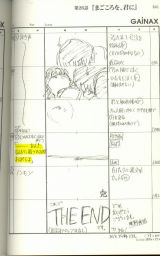
Discarded endings
The two discarded endings are referred to as "Last A" and "Last B".[10] The first one is the most similar to the ending we see on screen, while the second is more derivative and darker. Given to this proximity of Last A with the end of the film, the information contained therein are generaly taken into account for the interpretation of the scene and its meanings.
Last A
Last A starts out exactly as we know it. The difference lies when the gravemarks are seen.[11][12] The names of the main characters can be read written on them, except for Rei Ayanami. When the camera focuses on Asuka's gravemark, we see it being kicked down by herself. The following scenes are also similar to the ones we know, except for the final sentence: instead of "Kimochi warui", Asuka says something like: "Idiot. No way I'll let you kill me", with the "Idiot" being suppressed. The ending credits roll in a horizontal scroll, just like GunBuster. During the credits sequence, we were to see Eva-01 lying on the Moon, and woman's hair showing from its broken mask, with her face remaining unseen. Behind Eva-01, you could see Earth, entirely red, and the Black Moon, destroyed. The camera goes to the sun, then to the stars. The End.
Last B
Last B would start out exactly like A, but we wouldn't have the appearance of Asuka or the gravemarks. Shinji would be on the beach holding another hand. He would then say:
"I'll never see them again."
"It's better to think of it this way."
"I'm still alive, so I'll keep on living."
Shinji would press the hand harder, and then Rei Quantum would appear, exactly as seen in the movie. The camera would then reveal that the hand Shinji was holding belonged to a disembodied arm. The moon is shown and horizontal credits roll.
Last A and Last B implications
The huge similarities between the end of the film and the alternative Last A lead us to believe that this one was followed. In fact, even the last line was preserved, but was later altered in an exchange between Anno and Yuko Miyamura (Asuka's voice actress), and by her suggestion, as Anno was still unsatisfied with this line.[13][14]
Several implications can be drawn from Last A. First, the fact that Asuka destroys her gravemark is an indication that she is recovered from her pre-Instrumentality injuries, and is also purely aware of what is happening, and rejects the idea of being dead. Probably, that way, the whole scene would not take place right after her return, but a while later. The change in her final line is perhaps the most intriguing factor. The original phrase would be rude, closer to how Asuka usually acts. Which genuinely contrasts with her empathetic attitude at the same time. This could imply that Asuka, despite being determined to start over, would not put her personality aside just to please Shinji or get in good mood with him. The fact that Anno was not happy with the line demonstrates the complexity of feelings involved there, which probably could not be resolved by a returning to the status quo, as the scene would imply.
As Miyamura emphasizes, the scene was changed from a more natural tone on Asuka's part to her tension. Her feelings are described by the voice actress as of disgust, by the presence of the man who is there.[15] Anno's words make it explicit that Asuka is aware of Shinji's attitudes when she was unconscious (something that is also reinforced in the instrumentality). Even through Asuka can empathize with Shinji, she can't deny the feeling of disgust she carries with him, which justifies the sentence.
With all this in mind, there's much debate over the canonicity of some details existing in Last A, but absent in the traditional ending, albeit with remnant evidence. For example, one of the gravemarks is broken, which can considered to be the one Asuka broke on her return in Last A, which also implies that she is in relatively healthy despite the bandages. Furthermore, the existence of names on the stakes also serve to reinforce that the gravemarkers was raised up by Shinji to his friends. Either because he doesn't believe they would come back, or hoping for their return.
Last B, on the other hand, has far more direct and negative implications. Shinji directly says that no one is coming back, and that he accepts it. His words and the fact that is holding a disembodied arm denote a nihilistic attitude. He just accepts the disaster and embraces pain. His realization that he will go on living anyway is the tragic conclusion he draws from his journey. In this version, Shinji would simply go on living, as there would be nothing left in the world, as no one would return. This makes room for the possibility that, in fact, no one else will come back. Something that, although sounds contradictory with Yui's words, is possible, given the fear that humanity faces, especially after the disasters of Second Impact onwards. The return of humanity depends on the will of each of the beings, and it is entirely possible that they choose not to come back. Asuka's absence in this version also implies that. While in Last A her return represents hope, in Last B her absence denotes suffering and also Shinji's disbelief.
Staff statements
Over the years, some staff members have been asked in interviews about their thoughts and ideas about the end of the movie, or, more specifically, about specific scenes. This session seeks to summarize these interview excerpts in order to make clear the authors' intention.
Note: Some of the translation of these interviews is done by fans, and may be subject to revisions. If you are fluent in Japanese, you can help us!
Director Kazuya Tsurumaki describes the ending as an broaden of the genre, presenting an ugly and unhappy ending, apart from a more conventional positive resolution. This has a lot to do with the profile of the professionals at Gainax at the time, made up mainly of otakus with a more insecure profile, which brought them closer to the audience. Something that also contributes to a message more relatable to the public and less an illusory, utopian, ending. [16]
A known situation is that Megumi Ogata (Shinji's voice actress) strangled Yuko Miyamura (Asuka's voice actress) during the recordings in End of Evangelion. This occurrence is confirmed and described by both. Ogata describes that they were not able to act convincingly during the (final) scene, and, being agitated, she strangled Miyamura. The act left Miyamura with speech difficulties, which impaired her diction for the last lines. Ogata apologized for her attitude. [17] Miyamura confirms by telling her version, about the difficulties with the last line in its original version (as seen in Last A) and the change that came in the exchange between her and Anno.[18][19]
Finally, in an interview for Evangelion Forever magazine, Ogata described what could be an inspiration for the scene. According to her, it was all taken from a situation that Anno's acquaintance went through with her boyfriend, where he started to strangle her, and she, not knowing what to do, caressed his face, which made him "come back to reality". [20] In the same interview, Ogata says that Anno advised her to act like him, not Shinji, for this scene. [21]
Speculation based on Third Tier Canon
Third Tier Canon includes information from licensed materials involving Gainax staff. They are usually based on internally extracted information or interviews with them, if not with Hideaki Anno himself.
Cardass card game
See also: Neon Genesis Evangelion: The Card Game
The franchise's card game has some comments printed among its cards. Gainax licensed and supported its production. Its canonicity level, however, is debatable.
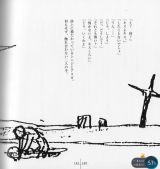
Interestingly, the EoE-related cards give some insight for some scenes and their interpretations. Card D-88, "Kimochi warui", for example, has the following description:
"Shinji renounced the world where all hearts had melted into one and accepted each other unconditionally. His desire... to live with 'others' -- other hearts that would sometimes reject him, even deny him. That is why the first thing he did after coming to his senses was to place his hands around Asuka's neck. To feel the existence of an 'other'. To confirm (make sure of) rejection and denial.".
According to this description, Shinji was trying to determine if Asuka was real or if he was still in Instrumentality, by confirming if in this world he could be rejected. Card H-11 goes even further:
"In the sea of LCL, Shinji wished for a world with other people. He desired to meet them again, even if it meant he would be hurt and betrayed. And just as he had hoped/wanted, Asuka was present in the new world. Only Asuka was there beside him. The girl who he had hurt, and by whom he had been hurt. But even so, she was the one he had hoped/wished for...."
This implies that Shinji had a special desire, after the instrumentality, to meet Asuka, in much because of the recent injuries that occurred between them, including inside the instrumentality. The cards continues:
"Neither Yui, Rei nor Misato could do as a woman for Shinji. Asuka alone was the only girl on equal footing with him. So, Shinji desired/sought after Asuka. "I'm afraid of Misato and Ayanami." However, Shinji's crude affection only hurt her. In the end, he used her as an object of lust/desire to soothe/ console himself..." [22]
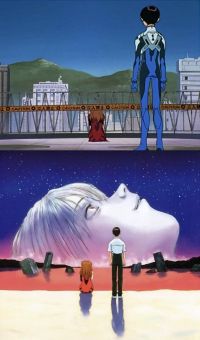
It is important to say that End of Evangelion deals with major themes of sexuality and human relationships, in a way that is very common to associate instrumentality itself to a sexual act. Thus, there is the thematic choice of the film to center the narrative on the two characters using this sexual scope: the search for pleasure and comfort. Shinji uses Asuka in this way throughout the entire film, and Asuka is aware of this, which is also confirmed in interviews. These card reinforce the strength of these themes and rescue this sexual undertone for the final scene. See more in Shinji and Asuka Relationship to understand the nuances of this relationship.
Evangelion Chronicle
See also: Evangelion Chronicle
Evangelion Chronicle is an encyclopedia-magazine dedicated to Neon Genesis Evangelion, and has Gainax/Khara endorsement on its production. Since it is supplementary material, it can be considered a relevant source of information, even if it's not definitive.
The Essential Evangelion Chronicle Side B has a character chart that describes the following:
"During Instrumentality, Asuka encountered Shinji inside his inner world and told him she didn't need anything if she couldn't have all of him. Despite the significance of this statement, Shinji's response was vague at best and he only sought a place at her side because it was a "comfortable" place to be. Hurt by the notion that she was nothing more than an escape for Shinji, Asuka outright rejected him. As a result, the Human Instrumentality Project did not reach its intended result, and any changes to the relationship between Asuka and Shinji were left unclear."
"Though Shinji and Asuka are both EVA pilots and living under the same roof、they are polar opposites. Despite their differences、Shinji did feel an attraction to Asuka at certain moments throughout their time together. When Shinji expressed his feelings to Asuka and sought her help during his instrumentality、she outright rejected him. Shinji and Asuka in the new world where the Human Instrumentality Project was not fulfilled Shinji had chosen a world where others existed, and for him Asuka became the first "Other"."
"Asuka Langley Soryu Piloting EVA-02 was Asuka's way of maintaining her self-respect, and it also served to deepen her confusing love/hate for Shinji. Her repeated failures in combat against the Angels during the war had forced Asuka to face her own weaknesses, and though she did make a comeback during SEELE's forced requisition of NERV headquarters, she fell in battle against the mass-production model EVA units. Immediately after Asuka's defeat, the Human Instrumentality Project was activated, Asuka was the first "other" to exist in the new world that was created when Shinji wished for a world where others existed, and she was found lying next to Shinji." [23]
These three different statements go to a common point: Asuka rejects Shinji, based on her own weaknesses. Later, however, she decides to return to the world where Instrumentality was rejected, and becomes Shinji's "first other".
"First other" is a term common to psychoanalysis to describe the relationship between a mother and baby, where the baby discovers the "other" in the mother. The other is the source of pleasure and satisfaction. Asuka, however, does not play a maternal role for Shinji, as Misato and Rei do. Their role, therefore, is to rediscover how they can act in the new world.
Evangelion Chronicle Volume 22 reinforces this interpretation:
"In the world where Shinji wanted to have others, Asuka became the first stranger, and Shinji reaches out to her [for her neck]. It is difficult to understand Shinji's emotions as he wonders if Asuka is the one who will hurt him or the one who will complement him.
Shinji and Asuka stand alone in a space where no one else is around. In her mental world, Shinji was rejected while expressing her feelings to Asuka and asking her for her salvation, but the relationship between the two can/will change in the new world." [24][25]
Both excerpts reinforce the idea of rejection by both, but also of a new beginning in the post-Instrumentality world. A positive message that matches the themes of the show. Shinji and Asuka will have the opportunity to deal with their own feelings differently and learn to deal with others without the fear of getting hurt.
Hegelian interpretation[26]
Evageeks forum user zlink64 developed a theory using basis from Hegelian philosophy to explain the final scene. G.W.F. Hegel was a German philosopher and and a colossal influence on Western philosophy. His essay on the master-slave dialectic is probably the most influential idea in his philosophy.
zlink64 also draws on the card game descriptions to extract the ideas that permeate Shinji's attitude toward Asuka, and in doing so draws the parallels present in Hegel's text.
According to Hegel, a consciousness is not aware of its state to some extent. When it becomes aware and finds another consciousness, the two must fight to the death so that they can prove their existence. This existence is proven by denying the conscience of the other. However, the winner must stop before killing the opponent, otherwise they will lose their proof. The “proof” would be the recognition of the other, gained by almost killing them.
Shinji is fulfilling his validation as a conscience by almost killing Asuka, but stopping in the act. In this way, he has the proof he needed from his own conscience. This is why it is described that they “need each other”. It is only self-awareness when you are based on the existence of another, just as a baby is based on its first “other”, the mother.
Thus, the Master (the one who wins the fight) allows the Slave (the one who loses) to live. Interestingly, for Hegel, the slave is the one who gains the most from this situation, as his existence is fully validated, while the master does not complete it. Hegel never explains in the essay how the master can become fully self-conscious.
zlink64 will also argue that, although Shinji is the one strangling, he is not the only master of the situation, with him and Asuka switching places at one given moment. As soon as Asuka caress him and then rejects Shinji (by saying she's disgusted), she becomes the Naster, and provides validation to Shinji. This would be a way to overcome the paradigm of the relationship between the master and the slave as Hegel proposed: the reciprocity between the two beings, equally. If both submit to the same, changing each other's role, both acquire their full consciousness.
Conclusion
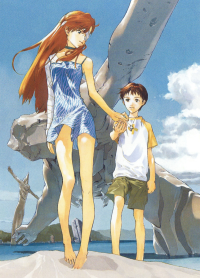
End of Evangelion certainly has an enigmatic and paradoxical ending, especially when compared to its anime counterpart. It is loaded with symbolisms and loose elements, which together form a narrative to be created. Either way, its message can still be deciphered, even though it leaves implications for viewers to interpret freely. What will happen to Shinji and Asuka after the final scene? We are free to think what we want. From the most positive to the most catastrophic views. And that's part of the beauty of the movie.
What the scenes imply is that the new birth of humanity has its costs, as well as its rediscoveries. The characters have a new opportunity to discover themselves and learn to deal with others going forward, but they will also have to deal with a world of uncertainty, facing the ruin of civilization as they knew it, and the return (or not) of people. All these elements are left to our imagination. But considering that Yui's words are hopeful, and that civilization prevailed even after the Second Impact disaster, the possibilities exist.
The most important thing to say is that Shinji and Asuka are now on a same level. Both, within their wounds, recognize their consciences. Asuka caresses Shinji and shows compassion to him, something that is unprecedented. Shinji, who attacks her, has a reality shock and realizes the condition they are in. Even though rejection is still a reality, they now have new resources to deal with it. And that way they can rediscover their places in the world. The passage of time gives evidence of a shift in Shinji's mood, but this interaction with Asuka may have clearly healed his spirit once he realizes he is no longer alone. Then he would be back to reality and aware of their condition.
Asuka's final line, "kimochi warui", as already said, can be translated as "Disgusting". It is an expression used many times before to express shock, discomfort or disapproval - for instance, when Shinji is first immersed in LCL in Episode 1 and in a sense embraced by Yui, and when Asuka complains about sharing a bathtub, and a house with Misato and Shinji in Episode 22, as she is unwilling to belong. Because of its unclear meaning, it is hard to say whether she's referring to Shinji, herself, or something else. It might be interpreted as how strange it feels for her to finally accept another person, for example.[27] When hostility would have been a far easier choice, she has instead chosen comprehension and compassion, she took a risk, just like Shinji did by choosing to return to reality. So, both are aware of the risks they have taken, and they know they will have to deal with it in new ways. Something that goes along with the series' original ending, too. Shinji understands all of his flaws, but if he is able to love himself, he can move forward, the same for Asuka, and for anyone else who returns.
The ambivalence in this scene represent the fact that they did not yet completely changed, but are beginning to open themselves to this. The movie leaves open where they will go from there, if they can grow and learn to love themselves or not, but even after all the grievous death and destruction throughout the movie, and even though they are still only starting to grow, it still gives them this hope, as long as they pursue it.
It is impossible to know for sure about the physical state of the world and its fauna and flora, availability of food and clean water, the preservation of buildings and infrastructure, etc. It is uncertain where they are, as well - possibly on the outskirts of the ruins of Tokyo-3, which has been flooded after Rei self-destroyed her Eva and later when the Black Moon emerged and created a crater. The physical damage might be limited to Tokyo-3's vicinity, or beyond, similarly to how Second Impact seems to have limited physical damage and LCL in the water to Antarctica.[28]
All possibilities are open: as Shinji and Asuka can learn, even if reality is harsh and uncomfortable, if they don't try to break out of the cycle of misery, despair and escapism which has encompassed them, they will only have the certainty of more failure and more suffering. However, if they decide to face reality and face the risk of rejection and failure, even if they will not have the certainty of success and attaining happiness, that is still the only way they can be happy in the first place.[29] This, in itself, synthesizes the message that the show wants to give us. Enigmatic, imprecise, but open to the best, if humanity so desires.
See also
Theory and Analysis:Shinji and Asuka's Relationship
Theory and Analysis:List of Common Misconceptions - The Adam & Eve Scenario
Resources:End of Evangelion Screenplays
This article was mostly built out of the following forum threads, please refer to them:
Passage of Time (EoE Final Scene)
What is the significance of characters strangling each other?
Notes and References
- ↑ (This is indeed Asuka alone and not a hybrid being)
- ↑ In both Netflix subtitles and dub, the line was translated as "Disgusting...".
- ↑ According to translations of the original script by Reichu and Bochan_Bird, [1]. The excerpt is: 墓標らしきもののが並んでいる (一本だけケリ倒されたもの有) “What appear to be gravemarkers stand in a row. (Only one is kicked down)”. Old discussions by Olivier Hague at EML also refer to this - [2]
- ↑ An alternative (and not contradictory) view can be seen there [3]. Readers should keep in mind that the author's argument starts from the point of total scientific accuracy and ignores any artistic license. The author's overall conclusion is consistent with the idea that at least two weeks passed between the characters' return. However, making the assumption that the positions of the moon and the Milky War are meant to be entirely accurate to real life, it would be at least seven months with the earliest possible date of July 19, 2016. See [4] to understand why we consider this part of the movie to be set on January 1st.
- ↑ “Yui: Don't worry. All living things have the ability to return to their original form... and the heart to go on living. Anywhere can be heaven as long as you have the will to live.”
- ↑ This was first hinted by Olivier Hague
- ↑ Olivier Hague's description
- ↑ Video sequence
- ↑ This song was originally written by Hideaki Anno, then adapted into English and sung by Arianne, the same criative process that Komm, Süsser Tod went through. Its original lyrics (in Japanese) is about a boy who can't get close to a girl without hurting her, while the girl also hurts him. A theme that is very present in the series and that can be applied to the two characters present. The adapted lyrics (now in English) have a more romantic and dramatic tone, although it also deals with the same themes.
- ↑ Original description
- ↑ Olivier Hague says they are described as resembling gravemarkers in both the storyboards and the after-recording script.
- ↑ According to Olivier, Anno states that it was Shinji who raised these gravemarks.
- ↑ Miyamura's original recording of this line is available on the Evangelion Blu-ray collection as part of the bonus material.
- ↑ Interview with Yuko Miyamura (BS AnimeYAWA) "I had been thinking directors should convey their ideal how the show should be to us. But Anno pitches us questions such as "What do you think for yourself if things went on such and such ways to you?" After recording all the lines of the movie, I was called to the studio because the final line needed to be revised. Ogata came there too as it was Asuka and Shinji's scene. Asuka's final line was "Anta nankani korosareru nowa mappira yo!" in the film scenario. Anno didn't live with my line no matter how many times I tried. Ogata and I were at a loss of how we should play what Anno wanted to express; she even tried to ride on me and choke me to meet his demand. He must have been pursuing reality. Concerning the final line we adopted, I'm not sure whether I should say about it in fact. At last Anno asked me "Miyamura, just imagine you are sleeping in your bed and a stranger sneaks into your room. He can rape you anytime as you are asleep but he doesn't. Instead, he masturbates looking at you, when you wake up and know what he did to you. What do you think you would say?" I had been thinking he was a strange man, but at that moment I felt disgusting. So I told him that I thought "Disgusting". And then he sighed and said "... thought as much." He said. " I thought as much. "
- ↑ I had been thinking he was a strange man, but at that moment I felt disgusting. So I told him that I thought "Disgusting".
- ↑ Amusing Himself to Death: Kazuya Tsurumaki speaks about the logic and illogic that went into creating FLCL
- ↑ "[...] There was a time when I actually pushed Yuko Miyamura to the floor to strangle her during the last scene of the "Evangelion" movie in which Shinji strangles Asuka. I couldn't act very well in playing that scene. I was so agitated that I strangled her too hard, making it impossible for her to say her lines for a while. Of course, I apologized to her for doing that. I almost killed her." Source: [5]
- ↑ "CF: Did Megumi Ogata (Shinji) really strangle you while recording the voices for the End Of Evangelion to get a realistic performance?
YM: Yes, she did. I tried many times to make it sound like I was being strangled, but I couldn’t get it right. So, Megumi Ogata helped me make realistic sounds by actually strangling me. She’s nice isn’t she!?"
Source: [6] - ↑ Interview with Yuko Miyamura (BS AnimeYAWA)
- ↑ "It seems to be modelled after a situation that actually happened to a woman Anno knew. She was being strangled, and at the moment she thought she might be killed—not Anno-san, by the way, just in case—She wanted to caress him, and that's when he came back to reality..." Source: [7]
- ↑ "Director Anno wanted to create a scene that could be interpreted in any way.
At that time, the scene direction only said "Sorry, please synchronise with me, not Shinji." - ↑ D-88, D-84, P-66, P-68, H-11.
- ↑ The Essential Evangelion Chronicle Side B
- ↑ **Translator's notes: "The verb kawaru (変わる) means to change. In this passage, we have kawatte (変わって), which means changed. Add iku (いく) and it means changing. Add nodarou (のだろう) means probably. [The relationship] will probably change. The nature of such indefinite change means it is still likely unclear. So those two sentences basically say the same thing (unclear vs will change). The former wording is used in the English translation of the Essential digest version, while the latter is used in the French translation.
- ↑ Evangelion Chronicle Vol. 22 (alternate translation from Japanese) - Asuka pages
- ↑ Note: This section is a summary of a post by a user on the Evageeks forum. For a full understanding of the original author's arguments, please refer to the thread: EoE Final scene explained and connected to EoTV G.W.F Hegel
- ↑ Keep in mind she is also fully aware of his masturbation in the hospital earlier, in fact, she not only tells him to do it again for her to watch, she even implies she knows it is a habit. That is to say, this was not the first time Shinji satisfied herself to her (presumably imaginary) image, even when he was not in moments of desperation. In fact, in one of the earlier EoE drafts, Shinji would just go home after seeing her exposed breasts and then masturbate in his room, thinking of her.
- ↑ Second Impact was an Impact of a very different nature, with an actual physical explosion caused by Adam's partial awakening. The 3 billion dead include subsequent natural disasters like tsunamis (provoked by the explosion itself and possibly the change of the Earth's axis), earthquake and rising sea levels, and conflicts including a nuclear exchange between India and Pakistan. The show hints that the post-2I world is politically unstable but perfectly habitable. This lack of certainty applies to the post-3I world as well.
- ↑ "I still don't know where to find happiness...but I'm here, and I will keep wondering why I was born."
